Tennessee Ratifies the 19th Amendment, August 18, 1920
Introduction
Text-to-speech Audio
The fate of the 19th Amendment ended up resting with Tennessee in 1920. After March 1920 35 states had ratified the amendment for women’s suffrage. Suffragists needed one more state for ratification, but eight states had already rejected the amendment and a few others were either undecided or had decided not to vote.
Images
Campaigning for suffrage in Chattanooga, 1912
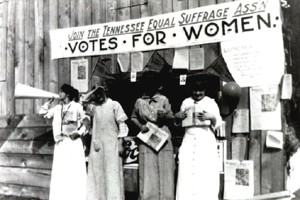
Nashville suffrage parade, c. 1915 (Tennessee State Museum)
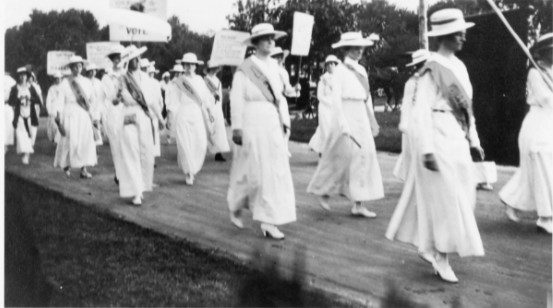
Banner of the Tennessee Equal Suffrage Campaign Committee
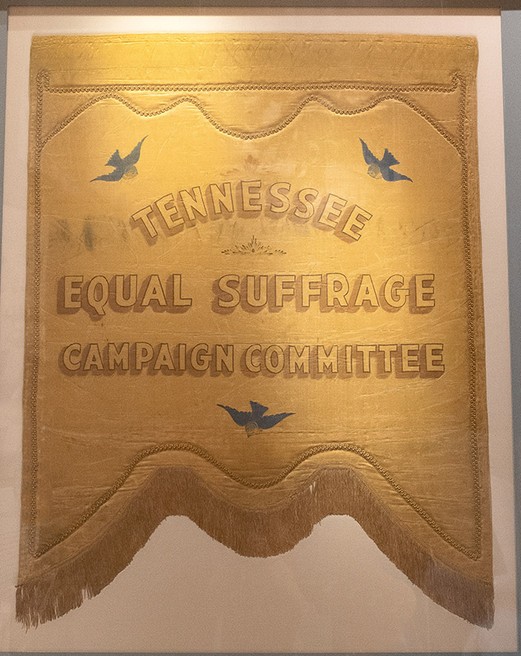
The Tennessee Senate Chamber as the votes are counted by the clerk (Nashville Tennessean, August 29, 1920)
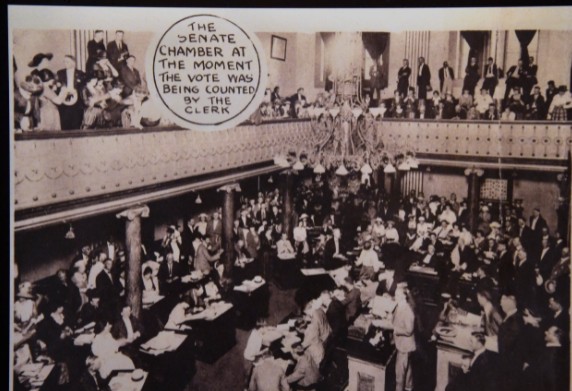
From the Nashville Tennessean: Gov. Albert H. Roberts signs the certification of ratification
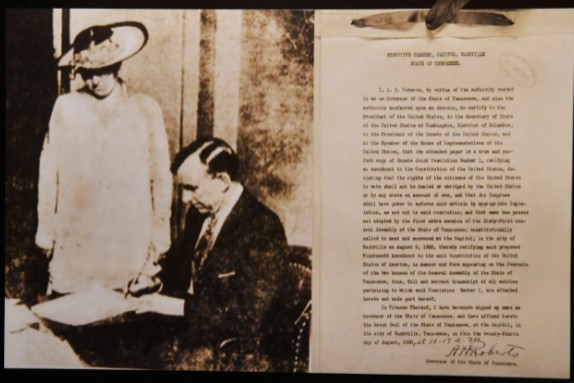
Representative Harry T. Burn
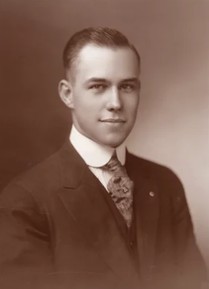
Suffragist Harriet Taylor Upton with Tennessee legislators who voted in support of ratification. Harry Burn is center in second row.
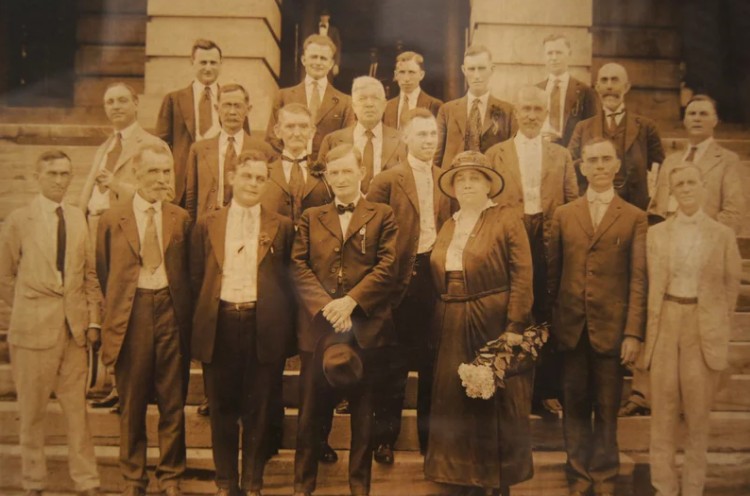
Febb Burn, mother to Harry T. Burn, was a strong supporter of women's suffrage and advised her some to vote for ratification.
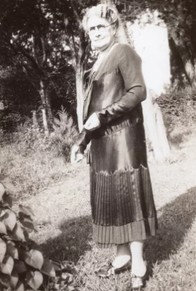
On October 9, 1920 Febb Burn registered to vote. The forms still used all male pronouns since the 19th Amendment was so newly ratified.

In 2018 a statue honoring Febb and Harry Burn was erected in Knoxville, TN.
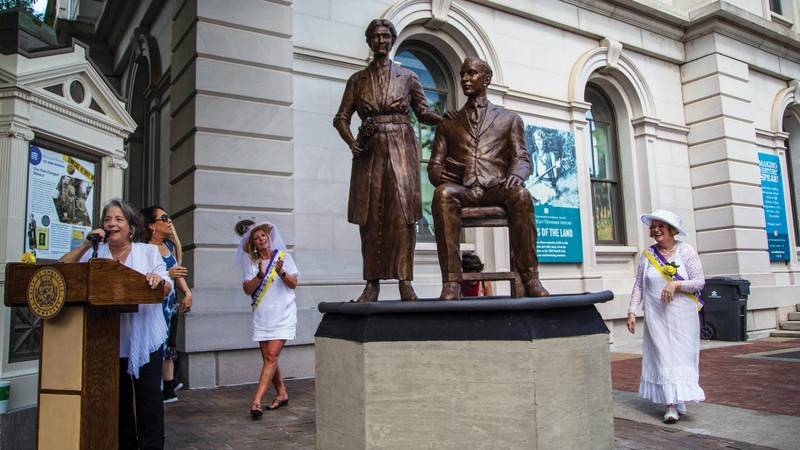
Alice Paul unfurls the ratification flag with 36 stars after Tennessee ratified the 19th Amendment.
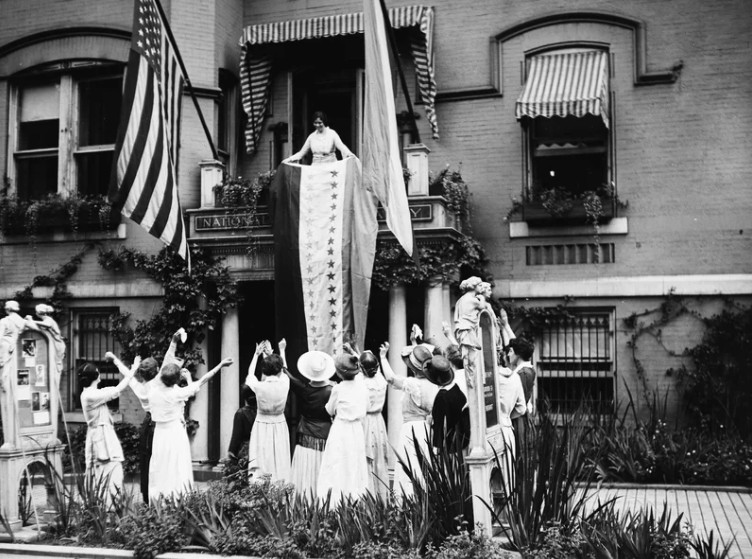
All eyes were on Tennessee when the special session convened in August 1920 (The Tennessean, August 10, 1920)
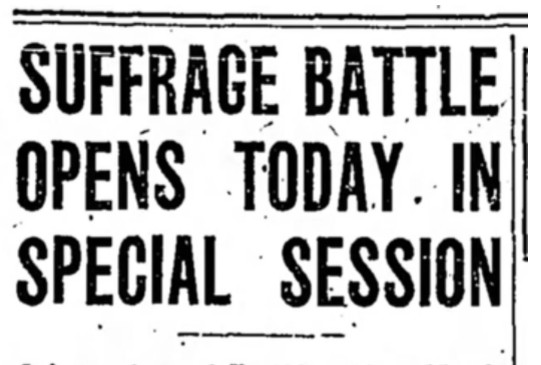
Backstory and Context
Text-to-speech Audio
The women’s suffrage movement in Tennessee began in the 1870s and 1880s through the work of Elizabeth Meriwether and Lide Meriwether and the first suffrage organizations appeared in the 1880s and 1890s. After a lull in momentum, women again actively campaigned for suffrage starting in 1905 but Tennessee was a very divided state on the subject. There was a strong-anti suffrage movement in the state and the suffrage movement itself was extremely split after an argument in 1913. After the rift, there were two organizations that called themselves the Tennessee Equal Suffrage Association (TESA) (one was Incorporated and the other was not), and both considered themselves the official suffrage organization of the state. With several suffrage organizations working within the state, suffragists made some progress in getting legislation approved in 1915 and 1917, but these attempts were ultimately rejected by voters in 1917. In 1918 the two versions of TESA reunited and tried again to lobby the legislature for suffrage. That year Tennessee women were granted partial suffrage and could vote in municipal and presidential elections. Two months later Congress passed the 19th Amendment and sent it to the states for ratification.
By the summer of 1920 suffragists focused their hopes for the 19th Amendment on just a few states like Tennessee and North Carolina. Tennessee still had a strong anti-suffrage movement, which included the governor who was responsible to calling a special session to even consider ratification. Women from both the state and national suffrage movements converged on the capitol to convince Governor Albert H. Roberts to call the session, which he finally agreed to do at the end of June. Through July both the pro- and anti- suffrage movements focused all their attention in convincing members of the legislature to commit to their side. Sometimes the fight to win support for each side is called the “War of the Roses” because when a legislator committed to voting one way or the other women would give them a rose to pin on their lapel. Supporters of suffrage wore yellow roses while those for anti-suffrage wore red.
The special session of the Tennessee legislature convened on August 9, 1920. The Senate was majority pro-suffrage and quickly voted to ratify the amendment within a couple of days. The House was divided and seemed to be in the hands of anti-suffrage supporters. After a delay in the proceedings the House finally debated the amendment on August 17 and the House vote was scheduled for August 18. Two times the House voted, with the anti-suffrage supporters voting to table the amendment (thus killing the amendment by not voting on it). Each vote ended in a deadlock tie, 48-48. Finally, the House commenced a roll-call vote on ratification of the 19th Amendment. The anti-suffragists believed that they had enough votes to stop ratification and the suffragists needed one vote to change to their side to approve the amendment.
Twenty-four-year-old freshman delegate Harry T. Burn initially supported the anti-suffrage side. He wore a red rose to the vote on August 18 and voted twice to table the amendment. However, when the roll call vote occurred Burns switched his vote to supporting ratification. This was the tiebreaking vote that suffragists needed and when two other legislators switched their votes at the end of the roll call, it gave a constitutional majority that sealed the ratification of the 19th Amendment. Apparently, Burns’ mother, Febb Burn, had not heard anything about where her son stood on the issue and decided to write him a letter, which he received shortly before the vote. “Hurrah and vote for suffrage,” Febb Burns wrote, “and don’t keep them in doubt.” He decided to follow his mother’s wishes rather than caving to the political pressure of the anti-suffrage campaign. With the Tennessee vote on August 18, 1920, 36 of the states had ratified the 19th Amendment and on August 26, 1920 the U.S. Secretary of State signed the amendment into law.
Sources
Bliss, Jessica. "'It was down to us': Tennessee's critical role in giving women the right to vote." Nashville Tennessean. February 9, 2020. Accessed July 15, 2021. https://www.tennessean.com/in-depth/news/womenofthecentury/2020/02/09/tennessee-womens-right-vote-suffrage/2798754001/.
Block, Melissa. "The Nudge and Tie Breaker That Took Women's Suffrage from Nay to Yea." NPR. August 17, 2020. Accessed July 15, 2021. https://www.npr.org/2020/08/17/902345079/the-nudge-and-tie-breaker-that-took-womens-suffrage-from-nay-to-yea.
Sims, Anastatia. "Woman Suffrage Movement." Tennessee Encyclopedia. Accessed July 15, 2021. https://tennesseeencyclopedia.net/entries/woman-suffrage-movement/.
Skinner, Mary. "A Look Back at Tennessee's War of the Roses." Tennessee State Museum. Accessed July 15, 2021. https://tnmuseum.org/Stories/posts/a-look-back-at-tennessees-war-of-the-roses.
"Tennessee and the 19th Amendment." National Park Service. July 31. Accessed July 15, 2021. https://www.nps.gov/articles/tennessee-women-s-history.htm.
"Women's Suffrage: Tennessee and the Passage of the 19th Amendment." Tennessee State Library and Archives. Accessed July 15, 2021. https://sos.tn.gov/products/tsla/womens-suffrage-tennessee-and-passage-19th-amendment.
Sims, Anastatia. "Woman Suffrage Movement." Tennessee Encyclopedia. Accessed July 15, 2021. https://tennesseeencyclopedia.net/entries/woman-suffrage-movement/.
"Tennessee's role in the women's suffrage movement." Tennessean February 10, 2020. Accessed July 16, 2021. https://www.tennessean.com/picture-gallery/news/local/2019/08/16/tennessee-womens-suffrage-movement-19th-amendment-right-to-vote/2006670001/.
Skinner, Mary. "A Look Back at Tennessee's War of the Roses." Tennessee State Museum. Accessed July 16, 2021. https://tnmuseum.org/Stories/posts/a-look-back-at-tennessees-war-of-the-roses.
"Tennessee's role in the women's suffrage movement." Tennessean February 10, 2020. Accessed July 16, 2021. https://www.tennessean.com/picture-gallery/news/local/2019/08/16/tennessee-womens-suffrage-movement-19th-amendment-right-to-vote/2006670001/.
"Tennessee's role in the women's suffrage movement." Tennessean February 10, 2020. Accessed July 16, 2021. https://www.tennessean.com/picture-gallery/news/local/2019/08/16/tennessee-womens-suffrage-movement-19th-amendment-right-to-vote/2006670001/.
Block, Melissa. "The Nudge and Tie Breaker That Took Women's Suffrage from Nay to Yea." NPR. August 17, 2020. Accessed July 15, 2021. https://www.npr.org/2020/08/17/902345079/the-nudge-and-tie-breaker-that-took-womens-suffrage-from-nay-to-yea.
Block, Melissa. "The Nudge and Tie Breaker That Took Women's Suffrage from Nay to Yea." NPR. August 17, 2020. Accessed July 15, 2021. https://www.npr.org/2020/08/17/902345079/the-nudge-and-tie-breaker-that-took-womens-suffrage-from-nay-to-yea.
Block, Melissa. "The Nudge and Tie Breaker That Took Women's Suffrage from Nay to Yea." NPR. August 17, 2020. Accessed July 15, 2021. https://www.npr.org/2020/08/17/902345079/the-nudge-and-tie-breaker-that-took-womens-suffrage-from-nay-to-yea.
Block, Melissa. "The Nudge and Tie Breaker That Took Women's Suffrage from Nay to Yea." NPR. August 17, 2020. Accessed July 15, 2021. https://www.npr.org/2020/08/17/902345079/the-nudge-and-tie-breaker-that-took-womens-suffrage-from-nay-to-yea.
"Burn Memorial." Knoxville, TN. Accessed July 15, 2021. https://www.visitknoxville.com/listings/burn-memorial/1855/.
Block, Melissa. "The Nudge and Tie Breaker That Took Women's Suffrage from Nay to Yea." NPR. August 17, 2020. Accessed July 15, 2021. https://www.npr.org/2020/08/17/902345079/the-nudge-and-tie-breaker-that-took-womens-suffrage-from-nay-to-yea.
"Tennessee's role in the women's suffrage movement." Tennessean February 10, 2020. Accessed July 16, 2021. https://www.tennessean.com/picture-gallery/news/local/2019/08/16/tennessee-womens-suffrage-movement-19th-amendment-right-to-vote/2006670001/.
